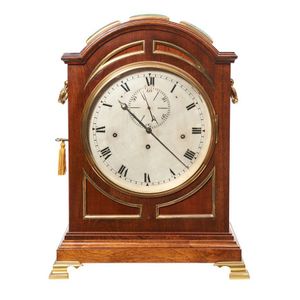Mahogany Bracket Clock by James Edwards of London
You must be a subscriber, and be logged in to view price and dealer details.
Subscribe Now to view actual auction price for this item
When you subscribe, you have the option of setting the currency in which to display prices to $Au, $US, $NZ or Stg.
- Regency Period - The Regency period in English furniture design refers to the period when King George III, was declared unfit to rule in 1811, and his son ruled as proxy as Prince Regent, until 1820, and then, after the death of his father as George IV until his death in 1830. The Regency period was preceded by the Georgian period (George I, George II, and George III: 1714 - 1811), and was followed by the William IV period, which only lasted until 1837 when William IV died as was succeeded by Queen Victoria.
- Finial - An architectural decoration, found on the upper parts of of an object. On furniture they are usually found on pediments, canopies and shelf supports. On smaller ceramic or silver items, such as spoons, they may decorate the top of the item itself, or the lid or cover where they provide a useful handle for removal.
Finials have a variety of shapes and forms. They may be urn-shaped, baluster shaped round or spiral, but usually taper into an upper point. Many real life shapes may also be used as finials, such as pineapples, berries, pinecones, buds, lotus and acorns. Sometimes animals such as a lion are depicted, or fish and dolphins. - Mahogany - Mahogany is a dense, close grained red-coloured timber from the West Indies and Central America. It was first imported into Europe in the the early 18th century and its use continued through the 19th century. It was popular for furniture making because of its strength, the wide boards available, the distinctive grain on some boards, termed flame mahogany and the rich warm colour of the timber when it was polished.. The "flame" was produced where a limb grew out from the trunk of the tree, and this timber was usually sliced into veneers for feature panels on doors, backs and cornices.
Some terms used to describe mahogany relate to the country from which it originally came, such as "Cuban" mahogany, "Honduras" mahogany etc. However unless the wood has been tested the names assigned are more a selling feature, rather than a true indication of the timber's origin.
This item has been included into following indexes:
Visually similar items

A George III table regulator clock, circa 1810, the break arch case with three brass trimmed rectangular glass panels set into the top of the arch. Circular cast brass bezel with brass inset panels above the dial and two brass inset panels below dial. Bras

A Regency mahogany bracket clock, early 19th century, with maker's mark of Vale, London, an elegant clock with a stepped pagoda top and a pineapple finial, an extended cornice with fluted detail above a painted dial with Roman numerals and a domed glass, b

Regency mahogany bracket clock white dial with Roman numerals, lion ring handles and glazed side panels and back door, moulded brass fee, two fusee movement unsigned and untested, height 50 cm

A George III bracket clock, John Holmes, London, circa 1800, the brass lined shallow break arch ebonised case with handle to the triple pad top, glazed, brass rimmed panels to each side. The circular enamel dial with inner Roman numerals and an outer minut
